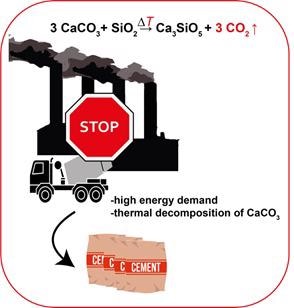Global warming and cheap housing are two main topics of public discussion. Climate protection is realized by decreasing greenhouse gas emissions, mainly carbon dioxide (CO2). Housing is created through more housing being constructed. This necessitates concrete, the most vital building material in today’s world.
 Conventional production of cement by burning lime (CaCO3) and sand (SiO2). During the reaction carbon dioxide (CO2) is released. (Image Credit: ©: Marcel Maslyk).
Conventional production of cement by burning lime (CaCO3) and sand (SiO2). During the reaction carbon dioxide (CO2) is released. (Image Credit: ©: Marcel Maslyk).
At an initial glance, concrete seems to be unproblematic. It does not comprise any fossil fuels, it is non-poisonous and it does not float in the oceans like plastic waste. But this notion is deceptive, because cement manufacture is presently the largest industrial emitter of CO2 emissions globally, contributing approximately 8% or 2.7 billion tons of CO2 annually.
This is because of the burning of fossil fuels — typically coal — at temperatures of about 1,000 °C and sintering at about 1,450 °C.
Concrete is very adaptable, economical, literally hard and can be cast into nearly any shape. It contains, in theory, only gravel, sand, water and the binder cement. The latter is made by the calcination of clay, lime and some other components, and develops stable calcium silicate hydrates during hardening, which are accountable for the properties of concrete.
However, the issue indeed lies in the calcination of lime (CaCO3), as for every molecule of calcium oxide (CaO) created, the so-called "quicklime" or "burnt lime," one molecule of the greenhouse gas CO2 is discharged.
For a yearly world production of about 4.5 billion tons of cement, it would mean 2.7 billion tons of CO2. This is equal to approximately half the yearly CO2 emissions of all transport. China is accountable for around 50% and Germany for 1.5% of the emissions from cement production.
Environmentally destructive calcination of lime is evaded by grinding raw lime with sodium silicate.
Chemists at Johannes Gutenberg University Mainz (JGU) in Germany have recently formulated a technique that could significantly decrease CO2 emissions from cement production. In this approach, the raw lime (CaCO3) is no longer turned into burnt lime in coal-fired kilns but is just milled with solid sodium silicate (Na2SiO3).
This milling step yields an "activated" intermediate that comprises the constituents of the cement in even distribution. When reacted with sodium hydroxide solution, a product is created that is structurally akin to the calcium silicate hydrates.
The formation of the cement paste and the setting with water progress via an intricate reaction cascade, are the fundamental steps of which have been analytically clarified using advanced procedures.
The calcination of the lime necessitates temperatures of 1,000 to 1,500°C, but, the milling step is performed at room temperature. At 120 kW hours for every ton, the mechanical energy input for grinding conventional cement is just around 10% of the energy utilized for the calcination process.
However, this is only equal to the energy saved — and the related CO2 emissions — by fossil fuel combustion in cement production. More significantly, avoiding lime calcination altogether could perfectly avoid CO2 emissions in the gigaton range. Since grinding is a regular process in the cement sector, it would be plausible to execute the process from lab to industrial scale.
Process Potentially Suitable for Large-Scale Production
The Mainz-based chemists stress that the energy and cost estimates are only rough estimates and that laboratory tests cannot be equated to an industrial process, where development, viability, design, maintenance and numerous other parameters must be taken into consideration. Plenty of development work is required for this.
This may be a first step for a non-conventional way of cement production, but it is not yet a fully developed solution.
Marcel Maslyk, Study Co-Author, Mainz University
Professor Wolfgang Tremel and Dr. Ute Kolb of Mainz University are of the same view. "The process is potentially suitable for producing cement for large-scale processes," said the two group leaders at the JGU’s Department of Chemistry. "However, carrying it out on a technical scale would take many years and thus would not provide a short- or medium-term remedy for CO2 emissions."
Journal Reference:
Schöttle, M., et al. (2021) Time–Temperature Integrating Optical Sensors Based on Gradient Colloidal Crystals. Advanced Materials. doi.org/.